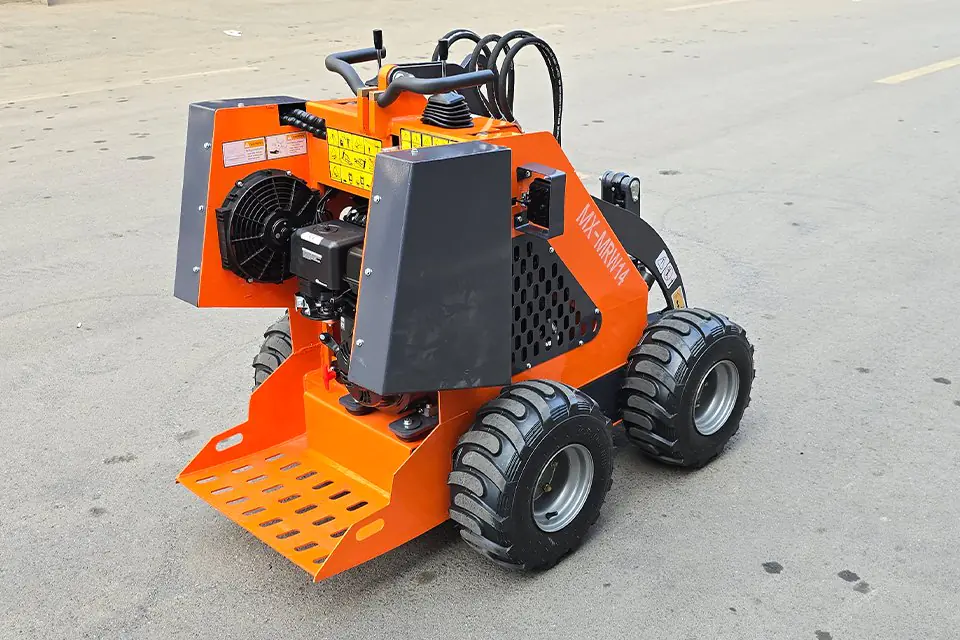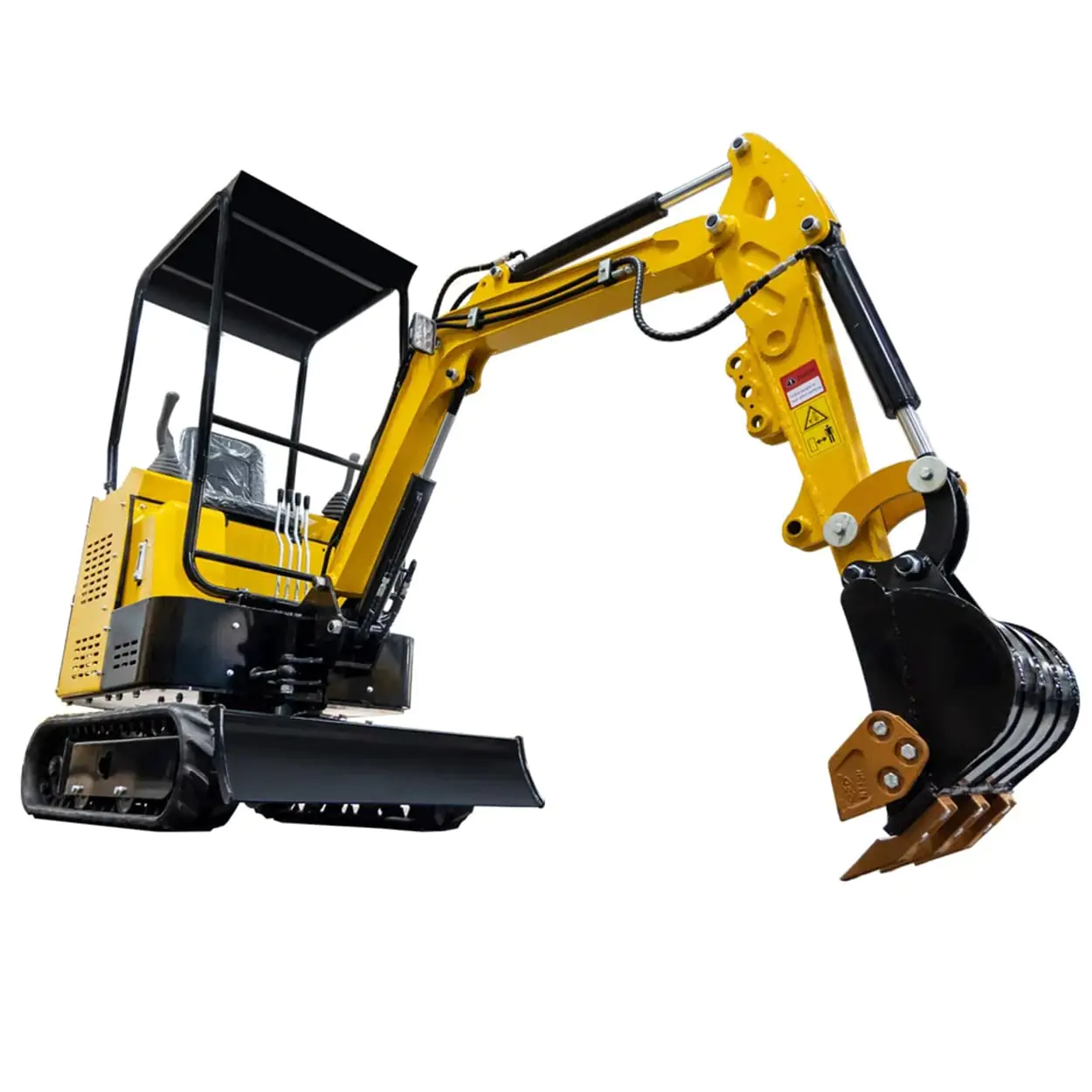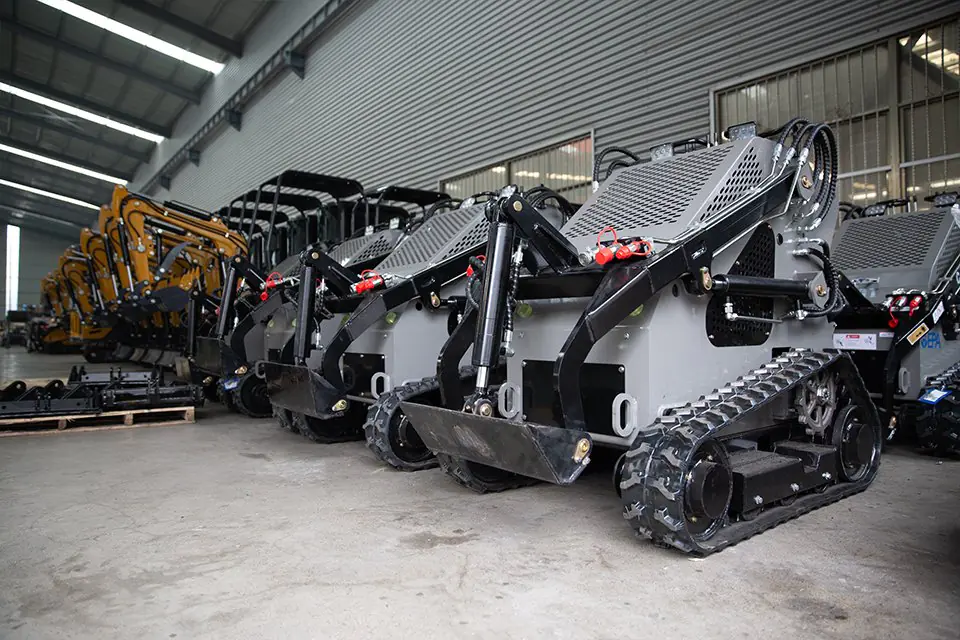Loading a skid steer onto a trailer may seem challenging, especially if you’re new to operating heavy equipment. In this comprehensive guide, we’ll walk you through the best practices and safety tips for loading your skid-steer loader, ensuring a smooth and secure transport. Whether you’re moving a Bobcat, a mini skid steer, or any skid-steer loader, understanding the proper way to load and secure your equipment is crucial. Read on to master the skills needed to load a skid steer safely and efficiently.

What Is a Skid Steer Loader?
A skid steer loader is a versatile piece of heavy equipment commonly used in construction, landscaping, and agriculture. With its compact size and maneuverability, a skid-steer loader can perform various tasks such as digging, grading, and lifting. The loader features a rigid frame and lift arms that can attach to a wide range of attachments like buckets, forks, and backhoes.
Skid steers are powered by an engine that drives the hydraulic system. Operators control the machine from an enclosed cab, using joysticks or levers to manipulate the loader and attachments. Due to their compact size and versatility, skid steers are a popular choice for jobs that require powerful machines in tight spaces.
Choosing the Right Trailer for Your Skid Steer
Selecting the right trailer is essential when transporting your skid steer. The trailer must be rated to handle the weight of your skid steer, including any attachments like buckets or backhoes. It’s crucial to ensure that the trailer’s axle capacity and overall weight rating are suitable for hauling your equipment.
There are several types of trailers suitable for transporting skid steers, such as flatbeds, tilt decks, and equipment trailers with ramps. Make sure the trailer you choose has a sturdy ramp or dovetail to facilitate loading. Additionally, verify that your towing vehicle is capable of handling the combined weight of the trailer and the skid steer, ensuring safe and legal transport.
Preparing Your Skid Steer for Transport
Before loading your skid steer onto the trailer, proper preparation is key. Start by performing routine maintenance checks on your loader. Inspect the engine, tires or tracks, hydraulic systems, and attachments. Fix any issues to prevent breakdowns during transport.
Next, remove any loose attachments from the skid steer. If you’re transporting attachments like forks or buckets, secure them separately on the trailer. Ensure the skid steer’s cab is clear, and all controls are in proper working order. Finally, confirm that the loader’s weight is within the trailer’s capacity.
How to Safely Load a Skid Steer onto a Trailer
Loading a skid steer onto a trailer involves careful attention to safety procedures. Follow these steps to load your skid steer safely:
- Position the Trailer on Level Ground: Park the trailer on a flat, stable surface to prevent movement during loading.
- Secure the Trailer: Engage the trailer’s brakes, and use wheel chocks on the trailer’s wheels to prevent rolling.
- Lower the Ramps: Ensure the ramps are properly extended and locked into place. Check that they can support the weight of the skid steer.
- Align the Skid Steer: Drive the skid steer in front of the ramps, aligning it straight with the center of the trailer.
- Slowly Drive Up the Ramps: Using low speed, carefully drive the skid steer up the ramps onto the trailer.
- Position the Skid Steer: Place the skid steer in the correct position on the trailer, balancing the weight over the axles.
- Engage the Parking Brake: Once on the trailer, engage the skid steer’s brake to prevent movement.
Always wear your seat belt and use proper protective equipment while operating the skid steer. If possible, have a spotter guide you during the loading process to enhance safety.

Positioning the Skid Steer on the Trailer
Proper positioning of the skid steer on the trailer is essential for safe transport. The weight should be evenly distributed, with slightly more weight towards the front of the trailer to maintain proper tongue weight on the hitch. This helps prevent swaying and enhances control while towing.
Aim to position the skid steer so that about 60% of the weight is in front of the trailer’s axle(s) and 40% behind. Adjust the skid steer’s position as needed to achieve the right balance. Avoid having too much weight at the rear of the trailer, as this can cause instability during transport.
Securing the Skid Steer: Chains and Straps
Once the skid steer is in position, it’s crucial to secure it properly to the trailer. Use heavy-duty chains or straps rated for the weight of your skid steer loader. Secure the chains to designated tie-down points on the machine, typically located on the front and rear of the loader.
Tighten the chains or straps to eliminate any slack. Use binders to ensure the skid steer is firmly secured and cannot move during transport. It’s a good practice to use at least four tie-down points, one at each corner of the skid steer, to prevent movement in any direction.
Understanding Weight Distribution and Axle Load
Understanding how weight distribution affects your trailer’s axle load is vital. Overloading an axle can lead to tire failure or damage to the trailer. Ensure that the combined weight of the skid steer and trailer does not exceed the axle ratings.
Use a weight scale or refer to manufacturer specifications to determine the weight of your skid steer and attachments. Distribute the load evenly across the trailer’s axles to prevent overloading a single axle. Proper weight distribution also improves handling and braking performance of the towing vehicle.
Loading a Skid Steer with Attachments
When loading a skid steer with attachments like buckets, forks, or backhoes, additional considerations are necessary. If possible, remove the attachments and secure them separately on the trailer to reduce the overall length and improve weight distribution.
If you must load the skid steer with attachments attached, ensure they are in a lowered position and secured. For example, lower the bucket to the floor of the trailer to prevent it from moving. Be cautious of the increased weight and adjust your securing methods accordingly.
Common Mistakes to Avoid When Loading Heavy Equipment
Loading heavy equipment like skid steers can be hazardous if not done correctly. Avoid these common mistakes:
- Not Securing the Trailer: Failing to chock the trailer’s wheels or engage the brakes can lead to the trailer moving during loading.
- Overloading the Trailer: Exceeding the trailer’s weight capacity can cause axle damage or tire blowouts.
- Improper Tie-Downs: Using inadequate chains or straps can result in the skid steer shifting or falling off the trailer.
- Ignoring Weight Distribution: Poor weight distribution can make towing dangerous due to trailer sway or loss of control.
- Not Checking Roadworthiness: Failing to inspect the towing vehicle, trailer, and skid steer before transport can lead to breakdowns or accidents.

Maintenance Tips for Your Loader Before Transport
Before transporting your skid steer, perform the following maintenance checks:
- Inspect the Engine: Check oil levels, coolant, and for any leaks.
- Check Tires or Tracks: Ensure tires are inflated to the correct pressure and tracks are in good condition.
- Verify Controls: Test the operational controls to ensure they respond correctly.
- Clean the Skid Steer: Remove any debris or materials that could fall off during transport.
- Secure Loose Parts: Tighten any loose bolts or components.
Regular maintenance not only ensures safety during transport but also prolongs the life of your heavy equipment.
Tips for Unloading the Skid Steer at the Job Site
After transporting your skid steer to the job site, unloading it safely is just as important. Here’s how:
- Park on Level Ground: Find a flat area to park the trailer.
- Secure the Trailer: Engage brakes and use wheel chocks.
- Remove Tie-Downs: Carefully release the chains or straps securing the skid steer.
- Lower Ramps: Ensure ramps are secure and can support the skid steer’s weight.
- Slowly Back Down: Gently reverse the skid steer down the ramps.
Always proceed carefully and be aware of your surroundings to prevent accidents.
Conclusion
Transporting a skid steer doesn’t have to be a daunting task. By following the proper procedures for loading, securing, and unloading your skid-steer loader, you can ensure a safe and efficient transport. Remember to select the right trailer, maintain your equipment, and adhere to safety guidelines. With these tips, you’ll be well-prepared to load a skid steer onto a trailer confidently.
Key Takeaways:
- Always choose a trailer rated for the weight of your skid steer and attachments.
- Secure the trailer and use proper ramps when loading and unloading.
- Position the skid steer to balance the load over the trailer’s axles.
- Use heavy-duty chains or straps to secure the skid steer firmly.
- Perform maintenance checks before transport to ensure equipment safety.
Looking for a compact yet powerful loader? Check out our Mini Skid Steer Loader for versatile solutions in tight spaces.
Need an efficient excavator for your job site? Explore our 2200 Lb Mini Excavator for reliable performance.
For precision landscaping, consider our Remote Control Lawn Mower to make your work easier.

In this article, we’ve covered the essential steps and considerations involved in loading a skid steer onto a trailer. By following these guidelines, operators can ensure safety and efficiency in transporting heavy equipment from one job site to another.
“Proper preparation and attention to detail make transporting heavy equipment not just possible, but straightforward.” – Skid Steer Operator
Join the Conversation
For more tips and experiences shared by professionals, visit our Operator Forum. Engage with a community dedicated to discussing equipment, best practices, and industry insights.
By mastering these techniques, you’ll not only improve your operational efficiency but also contribute to safer work environments. Remember, when it comes to transporting heavy equipment like skid steers, safety and preparation are paramount.












